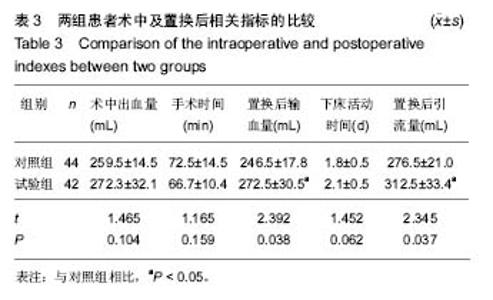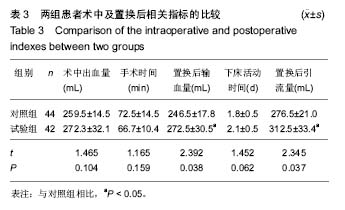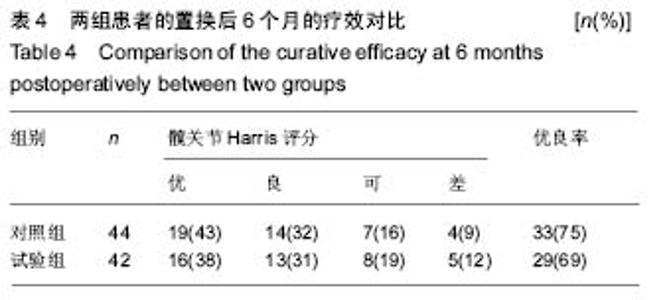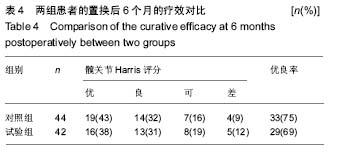Chinese Journal of Tissue Engineering Research ›› 2017, Vol. 21 ›› Issue (15): 2308-2313.doi: 10.3969/j.issn.2095-4344.2017.15.003
Previous Articles Next Articles
Effectiveness and safety of cemented versus cementless hip arthroplasty for senile unstable intertrochanteric fractures: study protocol for a prospective, nonrandomized, controlled clinical trial
Yu Tie-miao1, Miao Hui-ling2
- 1Department of Osteopathy, 2Department of Physical Examination, Harrison International Peace Hospital, Hengshui 053000, Hebei Province, China
-
Online:2017-05-28Published:2017-06-07 -
Contact:Yu Tie-miao, Department of Osteopathy, Harrison International Peace Hospital, Hengshui 053000, Hebei Province, China -
About author:Yu Tie-miao, Associate chief physician, Department of Osteopathy, Harrison International Peace Hospital, Hengshui 053000, Hebei Province, China -
Supported by:the Scientific and Technological Achievement of Hengshui City, No. 201440076-2
CLC Number:
Cite this article
Yu Tie-miao, Miao Hui-ling. Effectiveness and safety of cemented versus cementless hip arthroplasty for senile unstable intertrochanteric fractures: study protocol for a prospective, nonrandomized, controlled clinical trial [J]. Chinese Journal of Tissue Engineering Research, 2017, 21(15): 2308-2313.
share this article

试验于2014年1月开始收集病例,到2017年12月完成全部数据分析,目前部分结果如下: 2.1 基线资料分析 患者86例,女45例,男41例;年龄(72.76±5.31)岁;致伤原因:跌倒伤67例,交通伤12例,病理性骨折7例;所有患者均伴有同程度内科系统慢性疾病;骨折按Evans-Jensen分型[26]:ⅡA型10例,ⅡB型24例,Ⅲ型52例。骨质疏松按Singh指数分级[27]:Ⅳ级18例,Ⅲ级24例,Ⅱ级34例,Ⅰ级10例。 对照组共44例,男20例,女24例;年龄(72.25±5.54)岁;致伤原因:跌倒伤34例,交通伤6例,病理性骨折4例;骨折按Evans-Jensen分型:ⅡA型4例,ⅡB型13例,Ⅲ型27例,骨质疏松按Singh指数分级:Ⅳ级9例,Ⅲ级12例,Ⅱ级17例,Ⅰ级6例; 试验组共42例,其中男21例,女21例;年龄(73.34± 5.24)岁;致伤原因:跌倒伤33例,交通伤6例,病理性骨折3例;骨折按Evans-Jensen分型:ⅡA型6例,ⅡB型11例,Ⅲ型25例。骨质疏松按Singh指数分级:Ⅳ级9例,Ⅲ级12例,Ⅱ级17例,Ⅰ级4例。 2.2 两组患者术中及置换后相关指标的比较 试验组患者的置换后输血量及置换后引流量均高于对照组(P < 0.05),见表3。"

| [1] Liang C, Peng R, Jiang N, et al. Intertrochanteric fracture: association between the coronal position of the lag screw and stress distribution. Asian J Surg. 2017 doi: 10.1016/j.asjsur.2017.02.003.[2] Kempegowda H, Richard R, Borade A, et al. Obesity is associated with high peri-operative complications among surgically treated intertrochanteric fracture of the femur. J Orthop Trauma. 2017 doi: 10.1097/BOT.0000000000000825. [3] Yoo JI, Ha YC, Lim JY, et al. Early rehabilitation in elderly after arthroplasty versus internal fixation for unstable intertrochanteric fractures of femur: systematic review and meta-analysis. J Korean Med Sci. 2017;32(5):858-867. [4] Yang S, Liu Y, Yang T, et al. Early clinical efficacy comparison study of gamma3 nail, percutaneous compression plate (PCCP) and femoral head replacement (FHR) treatment on senile unstable intertrochanteric fractures. J Invest Surg. 2017 doi: 10.1080/08941939.2017.1282558. [5] Sun D, Park BS, Jang GI, et al. The fixation method according to the fracture type of the greater trochanter in unstable intertrochanteric fractures undergoing arthroplasty. Hip Pelvis. 2017;29(1):62-67.[6] Sonmez MM, Camur S, Erturer E, et al. Strategies for proximal femoral nailing of unstable intertrochanteric fractures: lateral decubitus position or traction table. J Am Acad Orthop Surg. 2017 doi: 10.5435/JAAOS-D-15-00691.[7] Yoo JI, Ha YC, Lim JY, et al. Early rehabilitation in elderly after arthroplasty versus internal fixation for unstable intertrochanteric fractures of femur: systematic review and meta-analysis. J Korean Med Sci. 2017 doi: 10.3346/jkms.2017.32.5.858.[8] Wada K, Mikami H, Oba K, et al. Cementless calcar-replacement stem with integrated greater trochanter plate for unstable intertrochanteric fracture in very elderly patients. J Orthop Surg (Hong Kong). 2017 doi: 10.1177/2309499016684749.[9] Arslan A, Utkan A, Koca TT. Results of a compression pin alongwith trochanteric external fixation in management of high risk elderly intertrochanteric fractures. Indian J Orthop. 2016;50(6):636-640.[10] Resch H, Krappinger D, Moroder P, et al. Treatment of periprosthetic acetabular fractures after previous hemi- or total hip arthroplasty: Introduction of a new implant. Oper Orthop Traumatol. 2016;28(2):104-110. [11] Kashigar A, Vincent A, Gunton MJ, et al. Predictors of failure for cephalomedullary nailing of proximal femoral fractures. Bone Joint J. 2014;96-B(8):1029-1034. [12] Hoff P, Maschmeyer P, Gaber T, et al. Human immune cells' behavior and survival under bioenergetically restricted conditions in an in vitro fracture hematoma model. Cell Mol Immunol. 2013;10(2):151-158.[13] Renken F, Renken S, Paech A, et al. Early functional results after hemiarthroplasty for femoral neck fracture: a randomized comparison between a minimal invasive and a conventional approach. BMC Musculoskelet Disord. 2012;13:141. [14] Chen DW, Lin CL, Hu CC, et al. Finite element analysis of different repair methods of Vancouver B1 periprosthetic fractures after total hip arthroplasty. Injury. 2012;43(7): 1061-1065. [15] Frenkel Rutenberg T, Daglan E, Heller S, et al. comparison of treatment setting for elderly patients with hip fracture, is the geriatric ward superior to conventional orthopedic hospitalization? Injury. 2017. pii: S0020-1383(17)30277-2. [16] Zhang YM, Jiang X, Sun YS. Effect of rivaroxaban on preventing deep-vein thrombosis in aged diabetics with femoral neck fractures after hip replacement. Biosci Rep. 2017. doi: 10.1042/BSR20170289. [17] Dudko S, Kosior P, Kusz D, et al. Factors Influencing Treatment of Proximal Femoral Fractures. Ortop Traumatol Rehabil. 2017. doi: 10.5604/15093492.1235277.[18] Kumar N, Wayne-Yap MQ, Ebk K. Lumbosacral Plexopathy in Pelvic Injury - A Cause of Hip Instability in Acetabular Fractures: A Report of Two Cases. Malays Orthop J. 2016; 10(2):61-65. [19] Thakur A, Lal M. Cemented Hemiarthroplasty in Elderly Osteoporotic Unstable Trochanteric Fractures using Fracture Window. Malays Orthop J. 2016;10(1):5-10. [20] Wang Z, Bhattacharyya T. Outcomes of Hemiarthroplasty and Total Hip Arthroplasty for Femoral Neck Fracture: A Medicare Cohort Study. J Orthop Trauma. 2017. doi: 10.1097/BOT.0000000000000814.[21] Yan M, Wang B, Li Y, et al. Analysis of prosthesis-related complications after extensible semi-joint prosthesis replacement for lower limbs osteosarcoma in children. Zhongguo Xiu Fu Chong Jian Wai Ke Za Zhi. 2015;29(10): 1194-1198.[22] 吕龙,牛啸博,张剑君,等.生物型加长柄关节置换治疗高龄股骨转子问骨折[J].中华骨科杂志,2012,32(7):637-641.[23] Castilian P, Bartra A, Vallro G, et al. Hip arthroplasty with conventional stem as rescue treatment after failed treatment of intertrochanteric hip fractures. Rev Esp Cir Ortop Tranmatol. 2013;57(3):194-200.[24] Barrack RL, Mulroy RD, Harris WH. Improved cementing techniques and femoral component loosening in young patients with hip arthroplasty. A 12-year radiographic review. J Bone Joint Surg Br. 1992;74(3):385-389.[25] Brooker AF, Bowerman JW, Robinson RA, et al. Ectopic ossiflcation following total hip replacement. J Bone Joint Surg (Br). 1973;55(8):1629-1632.[26] Jensen JS,Michaelsen M. Trochanteric femoral fractures treated with McLaughlin osteosynthesis. Acta Orthop Scand. 1975;46(5):795-803.[27] Singh M, Nagrath AR, Malni PS. Changes in trabecular pattern of the upper end of the femuran index of osteoporosis. J Bone Joint Surg Am. 1970;52(3):457-467.[28] 成世高,王万春,肖扬,等.骨水泥型人工股骨头置换治疗高龄不稳定型股骨转子间骨折[J].中国组织工程研究, 2015,19(52): 8373-8378.[29] Liu GB, Zhang GP, Ren QY, et al. Classification of ankle injury on radiography and magnetic resonance imaging: study protocol for a retrospective, self-controlled, clinical trial with 3-month followup. Clin Transl Orthop. 2016;1(4):170-176.[30] Chen Y, Qu S, Ma G, Meng JH, Ni XL. Femoral nerve block prevents deep venous thrombosis of the lower extremity after knee arthroplasty: a single-center randomized controlled trial. Clin Transl Orthop. 2016;1(1):1-5. |
| [1] | Xu Xinzhong, Wu Zhonghan, Yu Shuisheng, Zhao Yao, Xu Chungui, Zhang Xin, Zheng Meige, Jing Juehua. Biomechanical analysis of different ways of inserting Steinmann Pins into the femoral head [J]. Chinese Journal of Tissue Engineering Research, 2022, 26(9): 1313-1317. |
| [2] | Wei Guoqiang, Li Yunfeng, Wang Yi, Niu Xiaofen, Che Lifang, Wang Haiyan, Li Zhijun, Shi Guopeng, Bai Ling, Mo Kai, Zhang Chenchen, Xu Yangyang, Li Xiaohe. Biomechanical analysis of non-uniform material femur under different loads [J]. Chinese Journal of Tissue Engineering Research, 2022, 26(9): 1318-1322. |
| [3] | Xue Yadong, Zhou Xinshe, Pei Lijia, Meng Fanyu, Li Jian, Wang Jinzi . Reconstruction of Paprosky III type acetabular defect by autogenous iliac bone block combined with titanium plate: providing a strong initial fixation for the prosthesis [J]. Chinese Journal of Tissue Engineering Research, 2022, 26(9): 1424-1428. |
| [4] | Zhuang Zhikun, Wu Rongkai, Lin Hanghui, Gong Zhibing, Zhang Qianjin, Wei Qiushi, Zhang Qingwen, Wu Zhaoke. Application of stable and enhanced lined hip joint system in total hip arthroplasty in elderly patients with femoral neck fractures complicated with hemiplegia [J]. Chinese Journal of Tissue Engineering Research, 2022, 26(9): 1429-1433. |
| [5] | Xu Kuishuai, Zhang Liang, Chen Jinli, Ren Zhongkai, Zhao Xia, Li Tianyu, Yu Tengbo. Effect of force line changes on lower limb joints after medial open wedge high tibial osteotomy [J]. Chinese Journal of Tissue Engineering Research, 2022, 26(6): 821-826. |
| [6] | Shao Yangyang, Zhang Junxia, Jiang Meijiao, Liu Zelong, Gao Kun, Yu Shuhan. Kinematics characteristics of lower limb joints of young men running wearing knee pads [J]. Chinese Journal of Tissue Engineering Research, 2022, 26(6): 832-837. |
| [7] | Li Shuo, Su Peng, Zhang Li, Wu Qiulong, Hu Xiangyu, Lai Yuliang. Positive effect of supracondylar femoral osteotomy on the correction of knee varus based on three-dimensional reconstruction and finite element analysis [J]. Chinese Journal of Tissue Engineering Research, 2022, 26(6): 858-863. |
| [8] | Wang Shaoling, Wang Yanxue, Zheng Yaochao, Yu Shaojun, Ma Chao, Wu Shaoling. Feasibility of ultrasound-guided intra-articular injection in rabbit hip joint [J]. Chinese Journal of Tissue Engineering Research, 2022, 26(5): 657-662. |
| [9] | Zhao Tianyu, Jin Song, Zhang Di, Liu Xiaoxiao, Ma Jiang, Wang Ju. Baduanjin training for patellar tendinopathy in a randomized controlled trial: improving pain, muscle flexibility and lower limb balance stability [J]. Chinese Journal of Tissue Engineering Research, 2022, 26(11): 1662-1668. |
| [10] | Bao Hongyu Lü Dongmei, He Yun, Xia Delin, Chen Junliang. Incidence of osteonecrosis in rats with jaw versus femoral defects following zoledronic acid injection [J]. Chinese Journal of Tissue Engineering Research, 2022, 26(11): 1699-1704. |
| [11] | Chen Xinmin, Li Wenbiao, Xiong Kaikai, Xiong Xiaoyan, Zheng Liqin, Li Musheng, Zheng Yongze, Lin Ziling. Type A3.3 femoral intertrochanteric fracture with augmented proximal femoral nail anti-rotation in the elderly: finite element analysis of the optimal amount of bone cement [J]. Chinese Journal of Tissue Engineering Research, 2021, 25(9): 1404-1409. |
| [12] | Du Xiupeng, Yang Zhaohui. Effect of degree of initial deformity of impacted femoral neck fractures under 65 years of age on femoral neck shortening [J]. Chinese Journal of Tissue Engineering Research, 2021, 25(9): 1410-1416. |
| [13] | Chen Junming, Yue Chen, He Peilin, Zhang Juntao, Sun Moyuan, Liu Youwen. Hip arthroplasty versus proximal femoral nail antirotation for intertrochanteric fractures in older adults: a meta-analysis [J]. Chinese Journal of Tissue Engineering Research, 2021, 25(9): 1452-1457. |
| [14] | Cai Qunbin, Zou Xia, Hu Jiantao, Chen Xinmin, Zheng Liqin, Huang Peizhen, Lin Ziling, Jiang Ziwei. Relationship between tip-apex distance and stability of intertrochanteric femoral fractures with proximal femoral anti-rotation nail: a finite element analysis [J]. Chinese Journal of Tissue Engineering Research, 2021, 25(6): 831-836. |
| [15] | Liu Jiangfeng. Nano-hydroxyapatite/polyamide 66 composite filling combined with locking plate in the treatment of fibrous dysplasia of femoral bone [J]. Chinese Journal of Tissue Engineering Research, 2021, 25(4): 542-547. |
| Viewed | ||||||
|
Full text |
|
|||||
|
Abstract |
|
|||||



